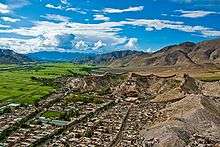Tibetan expedition by Islamic Bengal
| Tibetan expedition by Islamic Bengal | |||||||
|---|---|---|---|---|---|---|---|
| Part of Military history of Bengal | |||||||
 Bakhtiar Khilji led his army through harsh terrain into the cultivated valley of mainland Tibet, where he met fierce resistance and a guerrilla uprising | |||||||
| |||||||
| Belligerents | |||||||
|
|
| ||||||
| Commanders and leaders | |||||||
| Bakhtiar Khilji | Tibetan chiefs | ||||||
| Strength | |||||||
| 10,000 (approx.)[1] | Unknown | ||||||
| Casualties and losses | |||||||
| Several thousand; cavalry reduced to a few hundred | Unknown | ||||||
The Tibetan expedition by Islamic Bengal, also known as the Islamic invasion of Tibet, was an invasion of Tibet by Bengal under the Delhi Sultanate in the 13th century. It was led by Bakhtiar Khilji, the Muslim conqueror of Bengal.[2] Khilji was motivated by a desire to control the lucrative trade between Tibet and India. The expedition went up to the Chumbi Valley after crossing Sikkim and Bhutan, but was forced into retreat, and its failure is regarded as a "disaster".
Background
The Muslims conquered Bengal after overthrowing the Sena dynasty in Gaur between 1198 and 1202. Bakhtiar Khilji, the Governor of Bengal, subsequently became obsessed with ambitions of conquering Tibet. Bengal had traditional trade routes through Tibet to parts of China and Southeast Asia, which were home to gold and silver mines.[3] Tibet was also a source of horses.[4] Capturing Tibet would have allowed Bengal to control the northern Silk Road between China and Europe. The planned invasion also coincided with the Era of Fragmentation and the collapse of the Tibetan Empire.
The Expedition was addid by Ali Mech of the Mech tribe in the foothills of India. He was tribal leader and a recent convert to Islam. he helped the expedition through acting as a guide for them.[5]
Campaign
Khilji led the expeditionary force of 10,000 horsemen from Gaur and marched northwards along the Brahmaputra River.[6] He went through the territory of Kamarupa in the sub-alpine Himalayan hills, where his army crossed an ancient stone bridge on the Teesta River. Khilji courted the support the king of Kamarupa, who allowed Bengali forces to pass through his territory. The expedition marched through what is today Sikkim and Bhutan and reached the Chumbi Valley in mainland Tibet. The sultanate forces began plundering villages in the valley.
The invasion sparked a ruthless Tibetan uprising. Khilji ordered his forces to retreat, but all along the mountainous escape route, the Muslim army was attacked by Tibetan guerrilla forces. The invasion army was routed. There were further losses for the Muslim army as the Kamarupa kingdom blocked passage through the earlier Teesta bridge. Accounts speak of Khilji returning to Bengal with only a few hundred horsemen.[7][8]
Aftermath
There are two accounts of what happened to Bakhtiar Khilji following the Tibetan debacle. One account speaks of him dying from ill health and injury during this retreat to Bengal.[9] Another account notes that he was assassinated by Ali Mardan Khilji after returning to Devkot in Bengal.[7] Another version of events has him being killed by the rulers of Assam.[10] The expedition introduced Islam to many parts of India.[11]
See also
References
- ↑ Debajyoti Burman (1947). Indo-Muslim Relations: A Study in Historical Background. Jugabani Sahitya Chakra. p. 67.
- ↑ Khan, Muhammad Mojlum (2013-10-21). The Muslim Heritage of Bengal: The Lives, Thoughts and Achievements of Great Muslim Scholars, Writers and Reformers of Bangladesh and West Bengal. Kube Publishing Ltd. p. 19. ISBN 9781847740625.
- ↑ Farooqui Salma Ahmed (2011). A Comprehensive History of Medieval India: Twelfth to the Mid-Eighteenth Century. Pearson Education India. p. 53. ISBN 978-81-317-3202-1.
- ↑ P. K. Mishra (1999). Studies in Hindu and Buddhist Art. Abhinav Publications. p. 101. ISBN 978-81-7017-368-7.
- ↑ Siddiq, Mohammad Yusuf (2015-11-19). Epigraphy and Islamic Culture: Inscriptions of the Early Muslim Rulers of Bengal (1205-1494). Routledge. p. 36. ISBN 9781317587460.
- ↑ Elverskog, Johan (2011-06-06). Buddhism and Islam on the Silk Road. University of Pennsylvania Press. p. 130. ISBN 0812205316.
- 1 2 Nitish K. Sengupta (1 January 2011). Land of Two Rivers: A History of Bengal from the Mahabharata to Mujib. Penguin Books India. pp. 63–64. ISBN 978-0-14-341678-4.
- ↑ William John Gill; Henry Yule (9 September 2010). The River of Golden Sand: The Narrative of a Journey Through China and Eastern Tibet to Burmah. Cambridge University Press. p. 43. ISBN 978-1-108-01953-8.
- ↑ http://en.banglapedia.org/index.php?title=Bakhtiyar_Khalji
- ↑ Bhattacherje, S. B. (2009-05-01). Encyclopaedia of Indian Events & Dates. Sterling Publishers Pvt. Ltd. pp. A39. ISBN 9788120740747.
- ↑ Jr, Everett Jenkins (1999-10-01). The Muslim Diaspora (Volume 1, 570-1500): A Comprehensive Chronology of the Spread of Islam in Asia, Africa, Europe and the Americas. McFarland. p. 196. ISBN 9780786447138.